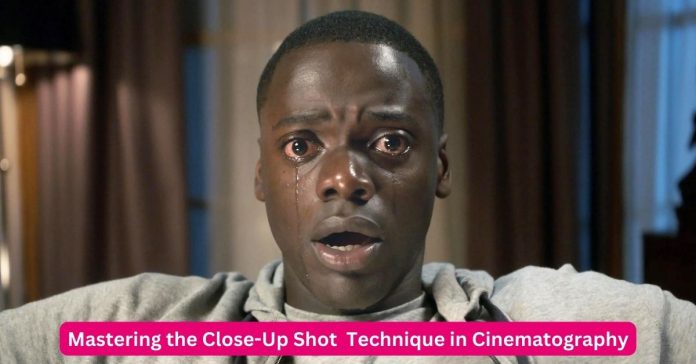Cinematography is an art that involves the intricate manipulation of visuals to convey emotions, tell stories, and immerse audiences into the world being portrayed on screen. Among the myriad of techniques at a cinematographer’s disposal, the close-up shot stands out as one of the most powerful and versatile tools. A well-executed close-up shot can capture the nuances of an actor’s performance, evoke empathy in the viewer, or highlight significant details crucial to the narrative. In this comprehensive guide, we delve deep into the world of close-up shot technique in cinematography. From its historical origins to modern applications, we explore the principles, methods, and creative possibilities that make close-up shots an indispensable element of visual storytelling.
Close-Up Shot in Cinematography:
Understanding Close-Up Shots:
A close-up shot, as the name suggests, is a type of shot that frames a subject closely, emphasizing its details and expressions. It isolates the subject from its surroundings, drawing the viewer’s attention to specific features or emotions. Close-up shots are typically used to intensify the emotional impact of a scene, reveal character depth, or highlight significant plot points.
Types of Close-Up Shots:
- Extreme Close-Up (ECU): In an extreme close-up shot, the camera zooms in on a particular feature or part of the subject, such as the eyes, mouth, or hands. This type of shot is highly effective in conveying intense emotions or emphasizing small details that might go unnoticed in wider shots.
- Close-Up (CU): A standard close-up shot frames the subject from the shoulders or chest up, capturing facial expressions and subtle gestures. It allows the audience to connect more intimately with the characters and their emotions, making it a valuable tool for character-driven storytelling.
- Medium Close-Up (MCU): Positioned between a close-up and a medium shot, the medium close-up shot frames the subject from the waist up, offering a balance between intimacy and context. It is often used to emphasize interactions between characters or convey a sense of proximity without completely isolating the subject.
The Art of Composition:
Composition plays a crucial role in the effectiveness of close-up shots. Cinematographers must carefully consider framing, angle, and camera movement to convey the desired mood and enhance the narrative impact. Here are some essential compositional techniques:
- Framing: The framing of a close-up shot determines what the audience sees and how they perceive the subject. Cinematographers can use tight framing to create a sense of claustrophobia or isolation, or they can employ negative space to evoke a feeling of emptiness or vulnerability.
- Angle: The angle at which a close-up shot is captured can influence the viewer’s perception of the subject. Shooting from below can make the subject appear larger and more powerful while shooting from above can convey vulnerability or weakness.
- Camera Movement: Movement adds dynamism and visual interest to close-up shots. Whether it’s a subtle tilt or a dramatic dolly-in, camera movement can enhance the emotional impact of a scene and guide the viewer’s attention to key details.
Technical Considerations:
Achieving the perfect close-up shot requires technical precision and attention to detail. From choosing the right lens to lighting the scene effectively, cinematographers must consider various factors to capture the desired image.
- Lens Selection: The choice of lens can significantly impact the look and feel of a close-up shot. A longer focal length lens, such as a telephoto lens, can compress perspective and create a shallow depth of field, drawing attention to the subject while blurring the background. On the other hand, a wider focal length lens can capture more of the surrounding environment, providing context and spatial awareness.
- Lighting: Lighting plays a crucial role in setting the mood and atmosphere of a close-up shot. Cinematographers can use light to sculpt the subject’s features, create shadows for dramatic effect, or highlight specific areas of interest. Soft, diffused lighting is often preferred for close-up shots, as it can flatter the subject and minimize harsh shadows.
- Focus and Depth of Field: Controlling focus and depth of field is essential in close-up cinematography. By selectively focusing on the subject while blurring the background, cinematographers can draw attention to specific elements and create a sense of intimacy. Techniques such as rack focusing can be used to shift focus between multiple subjects within the frame, adding visual interest and depth to the shot.
Creative Applications:
Close-up shots can be employed in a myriad of creative ways to enhance storytelling and evoke emotional responses from the audience. Here are some examples of how close-up shots are used in different genres and contexts:
- Drama: In dramatic films, close-up shots are often used to capture the subtle nuances of actors’ performances, allowing viewers to empathize with the characters on a deeper level. Close-ups can convey emotions such as fear, joy, or sadness with visceral intensity, making them indispensable tools for character-driven storytelling.
- Horror: Close-up shots are a staple of horror cinema, where they are used to create tension, suspense, and unease. By isolating the subject and obscuring the surrounding environment, close-ups can intensify the feeling of claustrophobia and heighten the audience’s sense of dread.
- Documentaries: In documentary filmmaking, close-up shots are used to capture the intimate details of real-life subjects and events. Whether it’s a close-up of a person’s hands at work or a tight shot of their face as they recount a personal story, close-ups can bring authenticity and emotional resonance to documentary footage.
Conclusion:
Close-up shot technique is a powerful tool in the arsenal of any cinematographer, offering endless creative possibilities for storytelling and visual expression. By mastering the principles of composition, technical execution, and creative application, cinematographers can harness the full potential of close-up shots to engage, captivate, and move audiences in profound ways. Whether used to convey raw emotion, reveal hidden details, or heighten dramatic tension, close-up shots have the power to elevate the art of cinematography to new heights of cinematic excellence.
Related: Mastering the Medium Shot Technique in Cinematography: A Comprehensive Guide




